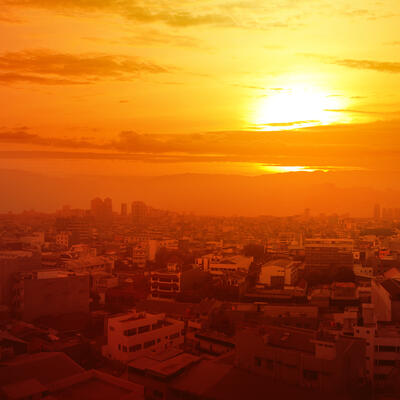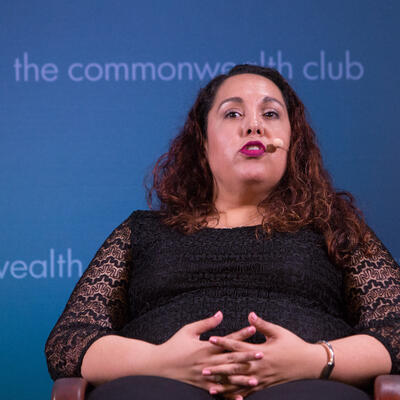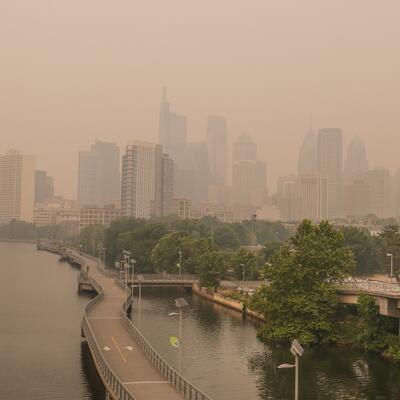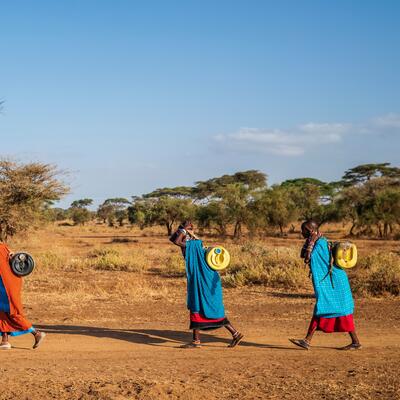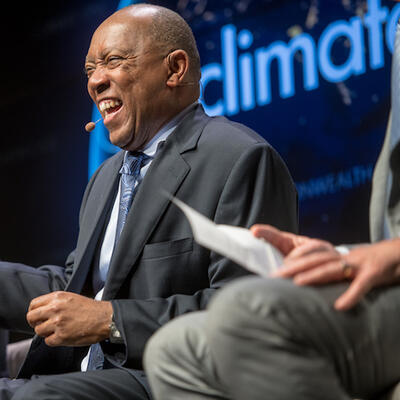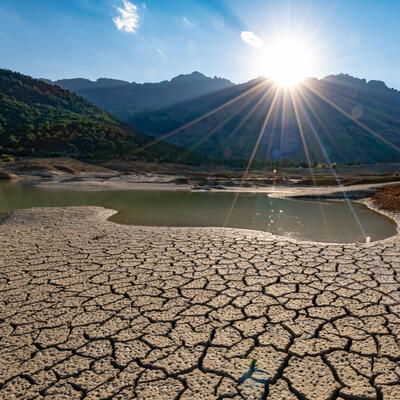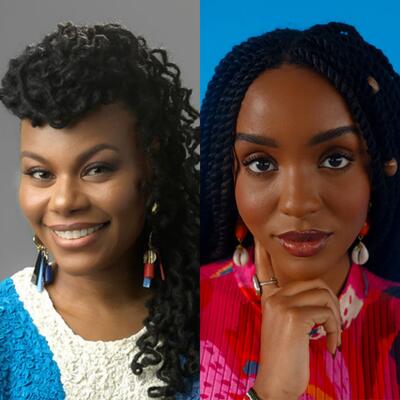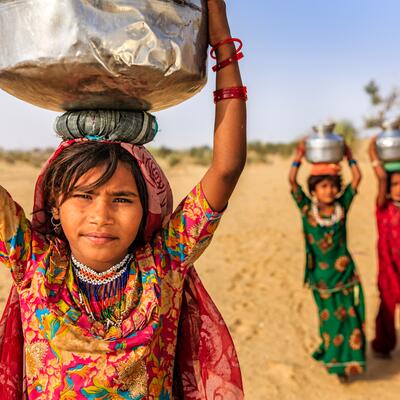
Killer Heat: Confronting Disproportionate Impacts on Women and Girls
Guests
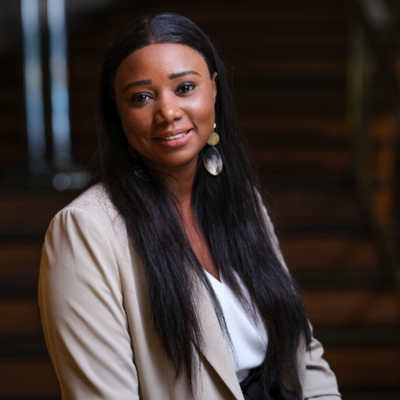
Eugenia Kargbo

Kathy Baughman-McLeod
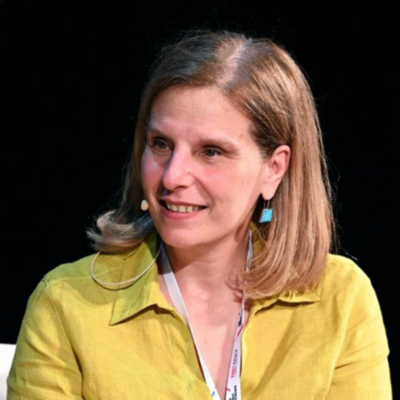
Eleni Myrivili
Summary
Extreme heat kills more people per year than any other climate disaster. It preys on the poor, exacerbates racial inequalities, and there is a growing body of evidence that shows women and girls are increasingly susceptible to heat-health effects. Globally, women and girls represent 80% of climate refugees. They are more likely to be displaced, suffer violence and die in natural disasters. As temperatures rise, children’s test scores decrease, gender violence increases, and miscarriage rates go up. But preventing heat deaths is possible. From Europe to Africa, Chief Heat Officers throughout the world are implementing projects to make cities more climate-adaptive.
Episode Highlights
4:15 – Extreme heat impacts are tied to race and discrimination
8:00 – How heat disproportionately affects women and girls
11:00 – Testing out “Extreme Heat Income Micro Insurance”
15:20 – Why we need to give heat events a name
25:00 – Athens is a “death trap” during severe heat
29:00 – Reactivating the ancient Roman aqueduct
32:30 – How heat impacts women differently
35:00 – Low-tech climate resilience in mud-wattle homes in Uganda
47:00 – How the Freetown Market Shade cover project is helping women
Resources From This Episode (3)
Full Transcript
Note: Transcripts are generated using a combination of automated software and human transcribers and may contain errors. Please check the actual audio before quoting it.
Greg Dalton: This is Climate One, I’m Greg Dalton.
Ariana Brocious: And I’m Ariana Brocious.
Greg Dalton: Extreme heat kills more people per year than any other climate disaster.
Ariana Brocious: And it’s a hidden threat–practically invisible compared to the torrential rain of a hurricane or drama of climate-fueled wildfires.
Greg Dalton: Soaring heat caused by burning fossil fuels preys on the poor and exacerbates racial inequalities – revealing vulnerabilities in its wake.
Ariana Brocious: And there’s a growing body of evidence that shows women and girls are disproportionately susceptible to heat-health effects.
Greg Dalton: Globally, women and girls represent 80% of climate refugees. They’re more likely to be displaced, suffer violence and die from natural disasters.
Kathy Baughman-McLeod: Women get the short end of the stick, in every way. And extreme heat is exacerbating and adding fuel to this profound inequality.
Ariana Brocious: That’s Kathy Baughman-McLeod, director of the Adrienne Arsht-Rockefeller Foundation Resilience Center. As temperatures rise, gender violence increases and miscarriage rates go up. But Kathy says preventing heat deaths is possible.
Kathy Baughman-McLeod: This is one of the most beautiful things about addressing this climate risk: you can solve this; people don’t have to die from heat.
Greg Dalton: The Arsht-Rockefeller Center has been funding Chief Heat Officers throughout the world – people implementing projects to make cities more climate-adaptive. People like Eleni Myrivili of Athens:
Eleni Myrivili: We have to start designing cities and transportation and kind of hospitals in special ways. And make sure that we have the right type of infrastructure that can support women as well as men in our modern cities.
Ariana Brocious: After we hear from Kathy, we’ll travel to a few different places dealing with heat, and hear about ways to mitigate it. From reviving an ancient aqueduct in Greece, to building mud-wattle houses in Uganda and putting shade and solar lights over an outdoor market in Sierra Leone. That’s all coming up.
Greg Dalton: One note about language before we begin. Extreme temperatures are commonly called heat waves. But the word wave implies we can just wait it out and it will pass. That’s true, AND those waves are becoming bigger and longer. I got a problem with that word “wave.”
Ariana Brocious: Yeah, and our brains are sort of hard-wired to forget about these kinds of episodic difficulties, which means that we need better systems to talk about heat. And one thing that Kathy and others are really advocating for is to have a naming system for naming heat events similar to what we do for hurricanes and other kinds of natural disasters, because it not only helps us to think about them in the moment, but also refer back to them and compare different events over time.
Greg Dalton: I also got a problem with the term “natural disasters” cuz they’re not really natural anymore. But let’s get on with it.
Ariana Brocious: Climate amplified.
Greg Dalton: There you go. The National Oceanic and Atmospheric Association just upped its odds of an El Niño event, which, for the first time, could put us over 1.5°of global warming set by the Paris Accord. I asked Kathy how she reconciles this news with her work.
Kathy Baughman-McLeod: I hate to say it but I knew it already and it's validation of our work. And it's also sad because we know exactly what to do and we know how to do it and we have the capital to do it, and the policies. We don't have the political leadership to do it. And that’s sad. The upside is that on the issue of addressing extreme heat. We do have solutions and things that we can do to protect ourselves. And so, this is a mixed emotions story.
Greg Dalton: And extreme heat kills more people per year than any other climate disaster more than floods, fires, hurricanes that grab the headlines. And I kind of knew that but didn't quite realize that deaths from severe heat increased 56% in the US between 2018 and 2021. I wasn't aware of that before studying up for this episode. So, how else does extreme heat affect people?
Kathy Baughman-McLeod: Well, it affects the human body in profound ways, and it affects people disproportionately. And that's one of the biggest elements of addressing climate impacts is it is an issue of climate justice that the story of extreme heat is a story of race and a story of discrimination. And when you think about the neighborhoods that or the environments in which people live many of them are leafy and green in wealthy areas. And many of them are covered in black asphalt with very little bits of nature. And that makes a big difference on our health and exposure to extreme heat increases asthma. It means that you have to run the air conditioner more. And if you don't have air conditioning that heat exacerbates underlying conditions that people have. And people in food deserts with little access to health and healthy food and healthcare end up having their conditions like diabetes or heart disease exacerbated by heat. And the scary part is, a lot of times these deaths and illnesses are masked. You know it's called the silent killer for a reason. We don't hear it. We can't see it. And we don't have a lot of data that tells us. And so, our numbers that you just cited that’s the best we can do. Oftentimes we have to model those numbers because we don't have the data to record it.
Greg Dalton: Right. And we've learned recently from studies that those neighborhoods with lots of asphalt in urban heat islands are those neighborhoods that were redlined by banks and there were not loans given and that there is a direct link between racism and heat in urban america.
Kathy Baughman-McLeod: I have a good friend, Adam Freed, who is an adjunct professor at Columbia. And in his class, he talks about the fact that these treeless neighborhoods with lots of asphalt it's racism that you can see from space. And that’s such a dramatic imagery that that brings I find that helpful.
Greg Dalton: I talked to a urologist once who said, yeah, he sees an uptick in patients during high heat because people are not hydrating. And think about all the people who don't get to see a urologist or a doctor during an extreme heat event. What else happens, workplace injuries, lost income. I think I remember one-time Sol Hsiang from UC Berkeley saying every day over say 90° is like putting a $20 bill on fire per person because of lost productivity, etc.
Kathy Baughman-McLeod: Well, at the macro level we work with Vivid Economics and we calculated the worker productivity losses for the US economy at $100 billion in 2020 as a baseline, so that's growing. And 18% of that loss is disproportionally borne by Black and Hispanic workers in the South. But we also looked at cities across the world and found that in New Delhi, a worker loses a quarter of their income every single day when they work outside. So, they're losing a full quarter has evaporated, and in Dhaka 8% of their GDP of the city is lost to heat. And in Miami-Dade County, completely different setting, you know, their annual budget is $10 billion. The cost of heat to their economy, just that one dimension, you know, that's not business interruption or healthcare or infrastructure just worker productivity is $10 billion. The same amount as their entire annual budget. And all of this is silent and unfortunately a bit of a secret which is why I’m thrilled to be on your podcast today.
Greg Dalton: In addition to disproportionate impacts due to race. Extreme heat also has disproportionate impacts on women and girls around the world, often because they're the ones fetching water, working outdoors. Tell us more about that, how heat disproportionally affects women and girls.
Kathy Baughman-McLeod: We work really closely with an organization called the Self-Employed Women's Association and they're based in India and they have 2.5 million women in the informal sector in 110 different trades. So, think about waste recyclers or market traders or construction workers. And we have learned very well their impacts which mean they even have blisters on their hands from using tools that are not made for the conditions they’re being used in. They have urinary tract infections, miscarriages, a rash that used to be a few months out of the year is now 12 months out of the year, headaches. It’s profound and most of the time they’re the primary breadwinner for their family. With these extreme temperatures. Work is shifted to different times of the day to try to find cooler times. And so, when there's a break, men can go back to work and women go home to take care of their kids, make dinner, clean up, put them to bed and they can't go out again and work. So, they're missing an entire shift and they're missing all the money that comes with that shift.
Greg Dalton: There is also research that shows across the board bad things happen when humans get exceptionally hot. Violence increases on all scales. There’s more domestic violence in the home, there's more people honking in the streets. There are more fights. There's even more interstate conflict. How does all of that affect women in their position of relative power in society?
Kathy Baughman-McLeod: Those are all absolutely true, and exacerbating the physiological the cultural. Women get the short end of the stick in every way. Culturally domestic violence, eating last, being responsible for getting water, clothes that cover their bodies fully. Being seen in many cultures as second- or third-class citizens. And extreme heat is exacerbating and adding fuel to this profound inequality. And we want to address that.
Greg Dalton: And you mention investing in women and girls. We know that all sorts of good things happen when girls stay in school and women are empowered. What are some solutions, particularly for heat in India or elsewhere that can really to address this disproportionate heat impact?
Kathy Baughman-McLeod: One thing we know is that women reinvest 90% of what they make back into their community. So, all boats rise when you invest in women and their economic viability and sustainability. And so, in India with the Self-Employed Women's Association we are testing a micro insurance product that pays to their bank accounts when their health is threatened by extreme heat. And it's called the extreme heat income micro insurance. And we’ve partnered with Self-Employed Women’s Association and Blue Marble, which is a private-sector micro insurance company, and we’ve developed this insurance. And the key thing is, it pays right to their bank accounts. And we've combined it though, you know, when you think about these insurance approaches, their risk sharing or risk transferring you also need to reduce the risk. And so, we've included in the program physical things that can help protect the women. And they choose what these things are including coolers to keep their water and their food and their produce from spoiling. Cement water tanks that keep the water temperature and the quality as it should be. Tarps that cover their crops to keep them from roasting in the sun. Gloves to protect their hands from the blisters that what I described that the ship breakers, the construction workers and the waste recyclers experience. And then thinking about early warnings they don't have access to good early warnings about heatwaves. And so, we're combining early warning system to the WhatsApp groups that they use to communicate with their grassroots leaders. And then lastly, there’s an element of financial inclusion. Thousands of the women are new to having their own bank accounts. They’re not banking through their father or their brother or their uncle. They have their own bank account. And so, there are lots of things happening within this one initiative. And so, we’re putting a lot of stock into it and it’s just been underway for about 10 days.
Greg Dalton: And that sounds really important because as part of this trend in insurance called parametric insurance, which is to release money before the bad thing happens rather than after the hurricane hits. And so, on the basis of a forecast of a heat or an extreme weather event to try to get money into people's hands beforehand rather than after something we knew was going to happen, but they couldn't get help until the damage was done.
Kathy Baughman-McLeod: Yes, a slight adjustment to that. So, the parametric is something that pays out when an event happens and a forecast based parametric again, I'm sorry about the jargon but something that’s gonna give you money three or four days before the bad things happens is what we want. And I was just in Ahmedabad and we met with several of the grassroots leaders that represent the women in the different trades. And these women themselves were in those trades and some still are. We asked we want to move this to a forecast based product, meaning you get notice and you get paid beforehand. How would that change your decision-making. And that was so informative because we saw wild excitement about changing when they might work thinking about arranging their childcare differently. Thinking about their food differently. Lots of solutions they had, of how they would handle if they got paid in advance of that heat. And much better than waiting for the time that it happens or shortly after. And so, the parametric pays when the heatwave is triggered and the forecast base means we can use a forecast to pay them. And so, where our next round of the pilot will be that which is testing the forecast based of the parametric. And so, we’re trying to get in front of it as much as we can.
Greg Dalton: Insurance can be a real powerful lever here. One of your initiatives that started a couple years ago has been naming heatwaves the way hurricanes are named. Beyond elevating the issue in the public consciousness, what does that do?
Kathy Baughman-McLeod: So, as we know heatwaves are invisible and they’re silent. And they’re called the silent killer. If heatwaves are silent. How can we solve it? How can we prevent people getting sick and dying from heat? And every death from heat is preventable. This is one of the most beautiful things about addressing this climate risk you can solve this; people don't have to die from heat. We need awareness. We need actual guidance. We need understanding of our own health, how to recognize signs of heat illness and stress in other people. And we believe and now have some early evidence that supports this that giving heat events a name gives them the branding and the identity that they need. Other climate hazards are so telegenic they’re dramatic, you know, the palm tree is sideways in the hurricane and a car is floating down a street, you know full of water in a flood, a landslide, tornado. I mean, they’re just grabbing your attention. And heat, you know, any aerial photo from one day to the next doesn't look any different. And it needs PR and people pay attention to human names. And now I’m excited to say that soon we’ll release our manuscript that shows the evidence that naming heatwave Zoe in Seville last summer was very successful in getting people to change their behavior and to think about the heat event differently.
Greg Dalton: Right. There was an infamous heatwave. And I don’t like to call it a wave because a wave has this idea that it comes and it goes, and this is more inexorable than that. But there was a heatwave in Europe, what 15, 20 years ago that killed tens of thousands of people and I don’t have a name for it, right. I have to describe it as that heatwave in Europe has no name that we can attach to it like we can Katrina or Ike or Sandy.
Kathy Baughman-McLeod: And there's an archival purpose to that too. Because you remember what happened during Katrina or you remember what happened during Sandy. And so, you know, we have the heat dome heatwave of the Pacific Northwest from 2021 or the Labor Day heatwave in California. I mean we need to name them. We need to keep them organized. We need to reference what happened. And so, it's quite logical. And we don't name heatwaves alone. We also what we’re doing is pairing it with a health-based heat warning system that projects the impact of a heat event on a specific community. So, taking that data from that community combined with an algorithm that we've built with our chief heat science advisor and a science panel that takes nighttime temperatures which are incredibly predictive of health events. So, when you don't rest at night, when you don't get the sleep that you need for your brain to clean out you wake up and you make mistakes. Whether you're at a computer or you are working with machinery, your hand eye coordination is off, you’re tired you make mistakes. Oftentimes, people, you know, there are lots of deaths associated with this sort of phenomenon. And there's maybe year ago, a study that looked at the worker's comp data from the state of California that came to some very eye-popping conclusions about heat and worker injuries. And so, the labor heat nexus is really strong. And so, we're really leaning into understanding the economics of that because the worker loses money and the company’s losing money. And these are just big opportunity for investing in better outcomes and protecting people.
Greg Dalton: Right. And a lot of warehouses are not built or air conditioned for this. Of course, building resiliency heat often means installing more air-conditioning which uses a lot of power. it can destabilize the grid. California's address that by bringing grid scale storage online and perhaps using electric vehicles. But what about this vicious cycle of more heat and more air-conditioning which makes the whole thing worse.
Kathy Baughman-McLeod: So, there’s a big movement for low emissions / no emissions mechanical cooling. And it’s not just the air-conditioners, you know, we need there's the cold chain is what it's called for food and medicine. Lots of medicines need to be kept at certain temperatures. We need to preserve and extend the shelf life of fresh fruits and vegetables; all sorts of health and well-being are depending on the cold chain in addition to the thermal comfort of our own bodies. We do have advancements in the machines themselves to make them lower emissions. They do have waste heat also so it’s not just emissions but they have heat. But the other pieces the passive cooling which is what we call things that without needing power things that can cool. And that means nature is one of the biggest ways that we can do it and one of the most cost-effective, trees, can make the difference. You know, there’s this concept of tree equity that American forests has coined and is looking at tree equity scores in cities around the US that thinks about the difference in a neighborhood with no trees and the same city, not very far away can be as much is 15°F cooler because of the trees. So, when you think about passive cooling, you have trees, you have lighter surfaces, you know, when we paint roofs and streets white. They reflect and don't absorb. There are green roofs so you put nature on the roof. And there are ways to design buildings for airflow. There are lots of ways to use water creatively so that you cool the air because it moves over the water. These very shallow little almost looks like a puddle, but it's designed and engineered specifically for cooling a community. So, we're looking at the combination of the passive cooling and the active cooling or mechanical cooling to try to bring down the demand. And then of course we want the power source for that mechanical cooling to be renewable. We need solar and wind to be powering it. And so, yes, we’re gonna need a lot more air-conditioning but we’re gonna try to do it in the very best way we can.
Greg Dalton: Kathy Baughman-McLeod is Director of the Adrienne Arsht Rockefeller Foundation Resilience Center and Senior Vice President at the Atlantic Council. Kathy, thank you for sharing again, the impacts of heat on women.
Kathy Baughman-McLeod: My pleasure. Thank you very much, Greg. And thanks for doing the show. May it be the silent killer no more.
Greg Dalton: You’re listening to a Climate One conversation about extreme heat. If you missed a previous episode, or want to hear more of Climate One’s empowering conversations, subscribe to our podcast wherever you get your pods.
Please help us get people talking more about climate by giving us a rating or review. Or send a friend a link to this episode–or even a whole playlist. Check out our new and improved website, climate one dot org, which has new tools for sharing your favorite episodes.
Coming up, how the city of Athens is employing ancient infrastructure to help mitigate extreme heat:
Eleni Myrivili: It really can make a difference between life and death. It’s a very significant lowering of temperatures.
Greg Dalton: That’s up next, when Climate One continues.
Greg Dalton: This is Climate One. I’m Greg Dalton, and we’re talking about extreme heat’s deadly impacts–particularly on women and girls. Eleni Myrivili is the Global Chief Heat Officer for UN Habitat. In the summer of 2021 she was appointed as Chief Heat Officer for Athens, and not a moment too soon. A few days later the city experienced a very significant heat event, with temperatures up to 45 degrees celsius – around 113 degrees fahrenheit. Myrivili says that hot and dry summer also led to intense wildfires around the city.
Eleni Myrivili: So, it becomes kind of a vicious circle, right. So, you have extreme heat and then you start having wildfires and the wildfires increase the heat. And not only increase the heat but they also increase the pollution and real difficulty in breathing. So, what I experienced was a kind of a post-apocalyptic scene where the skies were red and gray and brown because of the fires nearby, and where ash was falling everywhere. And where we couldn't breathe, I remember I had to wear my COVID mask to go to sleep because breathing was actually painful. It felt like it was hurting my lungs when I would breathe. So, and the Ministry of Health asked us not to leave the house for a few days because of these really high levels of microparticle pollution that is extremely dangerous for our health. But the main thing was that it was extremely hot. It was extremely hot. And the streets were empty, and people had withdrawn inside. And it lasted for three weeks. And months later we found out that several thousand people had died because of it. And what is interesting also is that the media was talking about the fires very, very little about the heat. And also, the media never, in Greece, never actually mentions the number of deaths. It was actually through politico.eu and a particular research that Politico did independently that measured different levels of mortality in different countries during that summer that we actually found out what the numbers were.
Ariana Brocious: Well, I think you're hitting on some really important things that we've talked about on past episodes of Climate One regarding heat, which is that there is not the same awareness publicly about the dangers of heat as there are for things like hurricanes or tsunamis or, you know, other kind of major natural disasters. And, yeah, there is not as good of accounting for the deaths. I live in the southwestern part of the US and there are excess heat deaths here as well, especially in cities like Phoenix. the data is not very good, even from the morgues, you know, what are the causes of deaths. And we know there are really harmful effects of heat on human bodies, especially when nighttime temperatures stay elevated. There's data for this because, especially big cities that have a lot of concrete and asphalt tend to absorb heat during the day, radiate it back out at night and then they don't cool off the ways to be some more rural or smaller cities do. What kinds of architectural and design solutions have been tried in Athens and other cities in the region to combat some of these effects?
Eleni Myrivili: Athens is particularly densely built and densely populated. It's one of the most densely populated parts of Europe. And it has tons of cement and asphalt and not very many green areas or rivers or any kind of natural water exposed in its surfaces. And that kind of city is not a good city for heat. It's a deathtrap. Because it absorbs heat in those types of materials, those mineralized kinds of surfaces which is the asphalt the cement, concrete, glass, steel, all these like really hard surfaces that are not water permeable and do not have any natural aspects about them. They absorb heat and then they radiate heat at night. And as you said that's the danger, that's the most dangerous type of heat. And we also know that nights temperatures are becoming hotter in the Mediterranean as well, more hot than, they are rising faster than the day temperatures some reports show. So, the night heat is really dangerous because the body never actually relaxes and never manages to adjust its core temperatures to lower its core temperatures and to sleep. So you’re less able to cope with the heat of the next day. So, you go to work particularly fatigued, but also your body and your organs, your internal organs have not managed to kind of lower their temperatures. So, that becomes particularly dangerous, So, in cities that are like this we immediately know that the neighborhoods that are the poorest neighborhoods, the most kind of vulnerable socioeconomically neighborhoods, which are the neighborhoods that almost everyone in the world have less green parks have worse quality in their infrastructure and worse quality in their buildings, those neighborhoods are the ones that will first of all kind of take the burden of heat. And those people that live there are the people that we have to make sure to protect.
Ariana Brocious: You’ve said that we need to move away from the logic of carbon modernity. Can you explain what you mean by that?
Eleni Myrivili: The industrial revolution brought together a kind of aesthetics and the kind of logic that created our modern cities with efficiency. And in a way a kind of democratization of resources. So, you know, we had these buildings that suddenly had central heating and we had electricity. But at the same time, it was based at this crazy idea of unlimited resources and most of all, it was based on the idea of unlimited fossil fuels that we can just use and abuse to do whatever we want. This type of cities the type of city that exists almost in a vacuum like we don't think any more of what are the climate conditions that these cities exist in. And we build the same city more or less whether we are in the South or whether we are in the North and just depend on fossil fuels to heat or cool them. And this is crazy because we've actually kicked a bucket full of knowledge from centuries of how people had learned how to what kind of materials to use, and how to build to deal with the local climate conditions in amazingly effective ways. We have to kind of get rid of the type of logic and aesthetics of modernity and start looking to other types of logics and bring other types of aesthetics into play when we design our cities from this point onward.
Ariana Brocious: The ancient Roman aqueduct that runs through Athens was reactivated. Can you explain what it was originally designed to do and what it's going to do now.
Eleni Myrivili: So, this ancient Roman aqueduct that was built in 150 after Christ to bring water to the center of ancient Athens during the Roman times, which at the time had a lot of demands on their bathing and spa. It was a big part of their social life and it continued to be used for many centuries. Water that run underground in this man-made extraordinary engineering feat, which is unbelievable to think about it. They would dig wells and connect the spaces between the wells and they manage for 24 km to keep it in a perfect type of inclination so that the water doesn't go too fast or too slow and continues kind of running for all these kilometers. And it's non-visible, it’s underground. It stopped being used for several decades now since there were centralized water supply for the whole of Athens. And recently we decided that we needed all types of backups for water supplies for Athens. And this was an incredible amount of water that is not being used and today is thrown into the sewage which is good quality and it needs very little further filtering to be used for irrigating green areas and for bringing water aspects to the surface of the city so that in both cases bring temperatures down.
Ariana Brocious: So, essentially, you're re-activating this pipe system. And that itself has a cooling effect on the city?
Eleni Myrivili: Exactly. So, if you use water either to help plants grow or to bring it to the surface through any kind of open water source. Be it, you know, misting or be it water spouts. All of these, especially in combination with green aspects with trees and other types of plants can bring temperatures down up to six or 7°C. It really can make a difference between life and death. It’s a very significant lowering of temperatures. The more you have heat, the more you need water, right. And we know that this is an important aspect for evapotranspiration which is this function that trees have which lower temperature. So, trees don't just help us deal with heat because they provide shade, but because also, they they release little water droplets that evaporate and cool our surrounding areas. So, trees are these amazing natural cooling entities.
Ariana Brocious: One of the threads we’re untangling in this episode is heat’s disproportionate impact on women and girls. What are you seeing related to this in Greece and elsewhere in Europe?
Eleni Myrivili: So, in cities like Athens and in cities in Europe and North America women tend to be more exposed to heat for several reasons. One of them is that we know through different reports that women end up working more than men. And also women end up taking more public transportation than men. And they also have to do more trips than men often because they have to go shopping and they have to pick up the kids and they have to go and take care of the elderly and all that. So, all of these things of caring, especially during times of crises like, you know, if you have a heatwave make women much more exposed to the heatwave and to conditions that can bring them to having physical problems, health problems. So, we also know that women that are pregnant are particularly vulnerable. And not just them but also the babies that they are carrying and the babies when they are first born are very vulnerable as well. So, this whole kind of thing means that we have to start designing cities and transportation and hospitals and particularly places that deal with very young children and women that are pregnant in special ways. And make sure that we have the right type of infrastructure that can support women as well as men in our modern cities. And to turn it back, Arianna, to your question. I just have to remind everyone that women are the ones that take care of every time that we have some vulnerable person in the family or in the extended family. It's the women that will have to stay back that will have to find the ways and the solutions and the resources to support these particular members of the family. And to take it a step further, that is why women are better at finding solutions for adaptation for heat. And we see them actually being in the forefront of solutions, because they are the ones that have to deal with this much more than to quickly kind of escape it or find other ways of dealing with it. They have to create the conditions that will protect their loved ones and the ones that are the most vulnerable.
Ariana Brocious: Eleni Myrivili is the Global Chief Heat Officer for the UN-Habitat. Thank you so much for joining us on Climate One.
Eleni Myrivili: Thank you for having me.
Ariana Brocious: Northern Uganda is facing increasingly frequent and severe heat events due to climate change, with temperatures reaching above 100 degrees fahrenheit. The periods of high heat particularly affect those who live in poverty and lack access to cooling technologies. However, there is an affordable, low-tech housing solution that has been used for generations. Contributor Hellen Kabahukya [kah-bah-huuk-yah] brings us this story.
Hellen Kabahukya: Imagine a place where the sun blazes overhead, and the air feels heavy and suffocating. Where the sun burns your skin and you sweat as early as 10am. This is the reality faced by the people of the northern part of Uganda. Especially during the peak of summer when temperatures reach triple digits. Local residents Anna Ochaya and Achiro Rose say the high temperatures have many impacts.
Anna Ochaya: The sunshine has been too much, and our things are drying up. Nothing we have planted is progressing because the whole place is drying up. This is making the situation very hard because you can hardly even find food for the children
Achiro Rose: The weather is hot and there are a lot of diseases. We suspect that it is this hot weather that might be causing us some of these illnesses.
Hellen Kabahukya: The scorching heat affects women and children significantly. They are responsible for various household tasks and farming activities that expose them to the sun for hours. The region is still recovering from the 20 year civil war. Those returning home have worsened deforestation to make way for development and farming, contributing to the heat waves. But Hellen Ojara of the Acholi culture says the ancestors knew better, and the knowledge passed down generations has been pivotal in safeguarding people against the unforgiving heat through the construction of mud-wattle houses.
Helen Ojara: The advantage of this house structure is that once built it is very comfortable for living.
Hellen Kabahukya: Now imagine a huge tree, the shade and the breeze it provides. As we step into one of the traditional mud-wattle houses, we are greeted by the same feeling. Anna Ochaya, a resident of Paicho village in Gulu district explains the benefits of traditional mud-wattle houses over more modern iron-roofed homes.
Anna Ochaya: It's always cool and fresh, even if it's hot outside, the grass makes the house cool because when you put grasses together, it doesn't heat up.
Hellen Kabahukya: Most houses have no windows or fans, but the wind gently passes through intentional air gaps in the thatched roof and the wall of the house, bringing a cool breeze inside and providing much-needed relief from the heat. As modern structures begin to shoot up in the town areas, it's not uncommon to see one or two mud wattle houses in the same compound. Even though modern structures built of cement and burnt bricks with corrugated iron roofs are seen as a form of wealth, people still rely on grass thatched houses as spaces to cool off and store produce.
Anna Ochaya: In our knowledge as occupants of a grass thatched house we feel the temperature in our house is better especially during this current situation of constant sunshine. Unlike a permanent house which would be too hot to even sleep, a grass thatched house is cooler and a fresh breeze at night allows the house to remain constantly cool.
Hellen Kabahukya: This low-tech solution is affordable even to the poorest of communities. The materials used are readily available in nature and for those in the peri-urban areas, the grass comes as cheap as 1$ per bundle. The unique construction techniques and choice of materials used in these houses have been passed down through generations. Asaba Morris explains the process:
Asaba Morris: You first dig some soil, you mix it with water into mud. The mud should be thick and not too wet. Then you lay bricks. We use mud for stomping the floor and laying foundation to prevent running water from entering the house and to avoid the floor from being too hard.
Hellen Kabahukya: There is specific grass and techniques used in the roofing. The pampas grass is laid down while the marram or elephant grass is laid on top. This type of grass can last for over 10 years if maintained well. When the construction is done, cow dung is mixed with ash or soil to make a paste to carpet the walls and floors of the house. Achiro Rose says this provides insulation to the house and keeps dust from rising up in the house which protects them from dust related diseases.
Achiro Rose: It’s as if it has been cemented. It remains neat and nice.
Hellen Kabahukya: These houses, with their ingenious design and natural materials, offer a sanctuary from the relentless heat, reminding us of the resilience and wisdom of the local communities in the face of changing climates. For Climate One, I’m Hellen Kabahukya in northern Uganda.
Ariana Brocious: This is Climate One. Coming up, why it’s important to center women when building heat resilience:
Eugenia Kargbo: We are in the market, we are in the schools, we are in the playground. When disaster strikes, women as caregivers suffer the most.
Ariana Brocious: That’s up next, when Climate One continues.
Ariana Brocious: This is Climate One. I’m Ariana Brocious. Just before the break we heard about the natural cooling effects of traditional mud-wattle houses in Uganda. Now we’ll travel to western Africa to hear my conversation with Eugenia Kargbo, Chief Heat Officer for Freetown, Sierra Leone.
Eugenia Kargbo: So I was born and raised in Freetown. All my life, I have my family here, I have my kids here. And growing up in Freetown, Freetown used to be very, very green with lots of green spaces, trees and flowers and, and plants just full of life and, and nature. And I remember I used to pluck fruit from the back of my compound cause we have lots of fruit trees around us. But in recent years we've seen that beauty goes away. This is mainly due to migration, urban, rural migration, which is as a result of climate impact, but also the uncontrolled development that we've seen. We've seen the city expand and the population more than double. A lot of the areas in the city where we've seen this expansion happening were mapped by the World Bank as disaster-prone areas. So Freetown is located geographically between steep hills, mountains and the sea. So as the city expands, it expands into the forest areas and into the coastal line, which has led to massive deforestation of the forest areas and the position of the coastal areas.
Ariana Brocious: And we'll talk in a minute about also some of the informal settlements that have resulted, I think from that same migration. But when you think about heat affecting your city, why are women maybe more vulnerable to heat than men?
Eugenia Kargbo: So in Freetown, everyone is exposed to extreme heat, but there are certain population groups and certain neighborhoods that are battling heat than others. So people even in the informal settlements, which are low income earning communities, people who outdoor workers are also badly affected by extreme heat, the elderlies people who are disabled, but more so women. We’re seeing women badly affected by extreme heat. Majority of the people who are now living in these informal communities were once farmers from the rural areas, who are mainly women and we've seen extreme heat and climate change badly affect the agricultural sector. And because of the lack of productivity in crop production, a lot of these women left to find greener pasture and livelihood. And in Freetown, most of where they are now are disaster-prone areas, and the housing condition is also a major challenge as majority of the houses within these informal settlements are built from corrugated iron sheets, which are called, commonly called zinc. Most of the structures do not have any ceiling, so these women also suffer from indoor temperature, directly by the sun’s radiation. A lot of these women also are informal workers and they're outdoor workers and mainly most of what they do is trading, they’re traders. And because of the increase in population and the lack of resources to manage this growth, we've also seen a lot of open air markets emerge, so areas or markets where there are no structures, there are no shade. So these women sell in the street of Freetown every single day exposed to the impact of extreme heat. And we know that prolonged exposure to heat causes several health implications and leads to productivity loss and economic loss.
Ariana Brocious: Are you saying a lot of the informal settlements where people live, they're, they're like zinc walled, but there's no roof structure? And I would imagine that the metal wall also retains heat and probably reflects it or radiates that, so it probably makes those structures even warmer, uh, in some cases. Is that true?
Eugenia Kargbo: Yeah. So in Freetown, 90% of the houses are built from either zinc or cement. And these are heat trapping materials that absorb the heat throughout the day and during the night, these materials and these structures radiate the heat. So a lot of people are also suffering from this. A lot of them, a lot of people in Freetown are talking about how they couldn't sleep because of the level of heat that they're also experiencing during the night. And we know that it is very important for our bodies to rest. And this just shows you the level of complexity and the level of the issues that this has on the human body when you talk about mental health and when you talk about wellbeing. So inasmuch as people are suffering outdoors, they're also suffering indoors.
Ariana Brocious: One of your main goals as Chief Heat Officer is supporting the implementation of long-term heat risk reduction in cooling projects, and one of these is the Freetown Market Shade cover project. Can you explain that project and how it's been helping the community?
Eugenia Kargbo: So the Market Shade Cover Project is an initiative that is supported by the Arsht-Rock Resilience Center in partnership with the city of Freetown. The project was co-designed and co-created with local residents and Freetown community people, but also the market women themselves based on an assessment that we did to understand the level of impact of heat exposure to women in the marketplace. And so the market shade cover project is our simple project that made use of a material that is called a Danpalon material. The Danpalon material is a micro cell polycarbonate panel, they are very lightweight and they are also reflective and semi translucent. So it allows light and air to flow through. The panels are installed on poles that are holding the sheets together, and these sheets have been in installed in three of Freetown’s major open air markets, providing shade and and protection to these women. We've seen a lot of benefits through the single effort and simple solution. When we talked to the women, they talked about how their goods and their products that they were selling are being badly affected by extreme heat because most of what they sell are fruit and vegetables. And when exposed to the sun, they perish. They also talk about how they've been affected by heat stress and how they couldn't stay in the areas where they're selling. They have to leave their market and, and run for shade because of the heat they're been experiencing. And they also talk about how they suffer during the rainy season from the rain. And so these shade covers do not only protect the women from the heat, it also helps to reduce the economic loss and increase productivity, but also helps to protect them during the rains. In addition to the shades, we also installed solar light underneath the cover to make use of the sun heat during the day and produce light for the women. This also has helped to expand the market hours of the women and create a safety net and serve as a safety net for the women.
Ariana Brocious: It's amazing to get so many benefits from that structure. So you have shade, reduced temperatures, increased economic benefit from not losing produce. And then the solar lights so you have more security and longer hours. That's really a lot. Can you share a specific story of an individual woman whose life has changed because of these shade covers?
Eugenia Kargbo: So I spoke to the market chair lady. Her name is Yel Amami and Yel Amami was the one that explained to us some of the issues that they faced in terms of the losses and she told me that she finds herself always very far away from the market area seeking shade cover. She feels as if she wants to bathe like 10 times in the day she talked about her head was always pain in her because of the exposure to the sun. And she also talked about how relief they feel right now and the relief that the shade covers are providing not only to her, but for all the market women. And my own personal testimony was when some of the women came to me and told me, we need this to be extended. We need this to be expanded cause there are lots of other women who didn't benefit from the project because the project is a pilot and we're only able to cover a certain portion of the market. And so they came to me and said, we are forming a committee and we are putting funding together to see how best these covers can be expanded to other areas so that other women can benefit from this.
Ariana Brocious: What do you hope to change as you begin to scale it?
Eugenia Kargbo: So after we implemented the project, we went back to the communities and to the market women to see what we can do to improve the living condition of women and to help reduce the impact of extreme heat. And whilst we are looking at the outdoor space, we are also looking at the indoor space. So for the outdoor market, we are looking at improving the design of the market to cover much more bigger and larger area. So instead of the rectangular design that we have now, we are looking at the toenail shape design where both vendors and shoppers can be covered and protected from the heat. We're also looking at indoor spaces as you also have a lot of structural markets, but because of the type of materials that we use and the way that the market are designed, women also in those spaces suffer from extreme heat. So we are looking at how do we design a climate smart market, one that we can make use of, or transform the waste from the market into biomass which can be used to power the structure of the market. We are looking at redesigning where we replace some of the windows and the doors with larger windows and doors to increase ventilation flow. We're also looking at the possibility to roll out, a green roof where you can have vegetables being grown at the top of the market and even the waste from the market can be used as a compost. And, as I said, biomass can also power the market and have market storage facility to further protect the goods that the women are selling. 60% of the waste that we produce in Freetown are organic waste. And so they produce a lot of methane. By converting the waste into biomass it helps to reduce the level of methane and the green infrastructure will help to reduce temperature and reduce heat stress for the women in the market, and this can also serve as the blueprint for other African cities in different countries.
Ariana Brocious: That's really a powerful vision of a market that's so integrated like that recycling itself. Let's talk a minute about disease. How do heat and mosquito borne illness compound each other?
Eugenia Kargbo: So studies have shown that heat exacerbates several disease burdens. And one of the major health issues we have in Freetown is malaria. A lot of people dying from malaria, especially pregnant women, and studies have shown that when temperatures are extremely high, people get angry and agitated easily, and that's the same for mosquitoes. So they tend to bite more when the temperatures are hot. And they tend to bite more people. So we've seen a lot of issues and increase in vector-borne diseases such as malaria. And this is really affecting the health of women and children.
Ariana Brocious: Uh, I did not know that about it increasing, like the likelihood of them to bite. That's interesting. Disheartening. So as we wrap up here, I'm curious if you think there's anything in particular about being a woman that makes you a good Chief Heat Officer, given that there are some of these disproportionate effects we've been talking about.
Eugenia Kargbo: Yes. So I think that this is very important and critical to have the voice of women, cause we understand the issues. I usually say that we are everywhere. We are in the market, we are in the schools, we are in the playground. When disaster strikes, women as caregivers suffer the most. They have to take care of the kids, they have to take care of their husband, they have to take care of several other members of the family. So it's important that we also have a voice.
Ariana Brocious: Eugenia Kargbo is Chief Heat Officer for Freetown.
Greg Dalton: On this Climate One... We’ve been talking about confronting disproportionate impacts of extreme heat on women and girls.
empowering conversations connect all aspects of the climate emergency. To hear more, subscribe wherever you get your pods. Talking about climate can be hard-- AND it’s critical to address the transitions we need to make in all parts of society. Please help us get people talking more about climate by giving us a rating or review. You can do it right now on your device. You can also help by sending a link to this episode to a friend. On our new website you can create and share playlists focused on topics including food, energy, EVs, activism. By sharing you can help people have their own deeper climate conversations.
Ariana Brocious Brad Marshland is our senior producer; Our managing director is Jenny Park. Austin Colón is producer and editor. Megan Biscieglia is our production manager. Wency Shaida is our development manager, Ben Testani is our communications manager. Our theme music was composed by George Young (and arranged by Matt Willcox). Gloria Duffy is CEO of The Commonwealth Club of California, the nonprofit and nonpartisan forum where our program originates. I’m Ariana Brocious.
